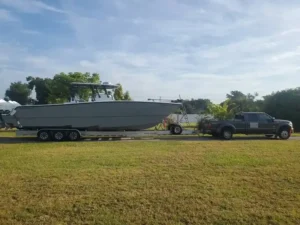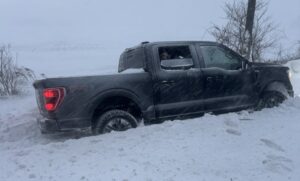The promise of a “jump start in seconds” is incredibly appealing when you’re faced with a dead car battery. For Toyota owners in Ontario, particularly in our Aurora community, the reliability of your vehicle is a key reason you chose it. However, even the most dependable Toyota can fall victim to a drained battery – perhaps from leaving lights on, extreme weather, or simply an aging power source.
While a “seconds-long” jump start might be possible under ideal conditions with specific equipment, the reality of safely and effectively jump-starting a dead battery in any Toyota, especially modern ones with complex electronics, involves crucial steps and precautions. At Pars Towing, your local experts in roadside assistance, we understand the nuances of Toyota service jump start procedures, ensuring your vehicle is handled with care and efficiency. This comprehensive article will demystify the jump-start process for your Toyota, explain why “seconds” might be an oversimplification, emphasize critical safety measures, and highlight when calling a professional like Pars Towing is the smartest and most reliable solution.
- Learn More >>>>Car Battery Booster
Toyota Service Jump Start a Dead Battery in Seconds: The Reality of Modern Boosts
1. Understanding Your Toyota’s Battery: The Heart of the Start
Every Toyota, whether it’s a trusty Corolla, a rugged RAV4, a powerful Tundra, or even a sophisticated Hybrid, relies on a 12-volt (12V) auxiliary battery to start the engine (or, in hybrids, to power the electronics that activate the hybrid system). This battery provides the initial burst of electricity to:
- Crank the starter motor (for gasoline/diesel engines).
- Power the car’s computers, sensors, and relays.
- Operate lights, infotainment, and other accessories.
When this 12V battery is depleted, your Toyota will show signs like:
- No response from the ignition (key turn or push-button start).
- Dim or no dashboard lights.
- Clicking sounds from the engine bay.
- Headlights or interior lights that barely glow.
For Toyota Hybrids (like the Prius or Highlander Hybrid), it’s important to note that the small 12V battery is often located in the trunk or under the rear seat, not under the hood. It’s still responsible for powering the electronics that “turn on” the high-voltage hybrid battery system. You are never jump-starting the large hybrid traction battery.
- Learn More >>>>Making Car Jump Starter PowerBank
2. Safety First: Absolute Precautions Before You Toyota Service Jump Start
Attempting to jump start any vehicle, including a Toyota, without proper precautions can lead to serious injury, damage to your vehicle’s sensitive electronics, or even fire. The “seconds” mentioned in the title refer to the brief connection, but the preparation and post-jump care are just as vital.
- Read Your Owner’s Manual: This is your primary source of truth. Your Toyota’s owner’s manual contains specific instructions for battery location, proper jump points, and safety warnings unique to your model. Always consult it first.
- Wear Safety Gear: Always wear safety glasses and gloves. Remove any metal jewelry (rings, watches) that could short-circuit terminals.
- No Smoking or Flames: Lead-acid batteries produce explosive hydrogen gas. Keep all sparks, open flames, and smoking materials far away from the battery.
- Ventilation: Ensure you are in a well-ventilated area.
- Vehicles NOT Touching: Ensure your Toyota and the booster vehicle (if used) are not touching each other.
- Turn Off Both Vehicles: Both the dead Toyota and the booster vehicle (or jump pack) should have their engines off and all unnecessary accessories (lights, radio, AC) turned off.
- Parking Brake: Engage the parking brake in both vehicles. Place automatic transmissions in “Park” (P) and manual transmissions in a low gear or neutral.
- Check Battery Condition: Visually inspect your Toyota’s battery for any signs of damage, cracks, leaks, or swelling. If you see any, do NOT attempt to jump start. Call Pars Towing immediately.
- Frozen Battery: Never attempt to jump start a frozen battery; it could explode.
3. What You’ll Need for a Toyota Service Jump Start
To effectively jump-start your Toyota, you’ll need:
- Jumper Cables: A high-quality set with good insulation and robust clamps. Ensure they are long enough (at least 10-15 feet).
- Booster Vehicle: Another vehicle with a healthy 12V battery.
- OR Portable Jump Pack: A lithium jump pack battery is an excellent, convenient alternative. Ensure it’s fully charged and rated for your vehicle’s starting current (Cold Cranking Amps – CCA). Many modern jump packs have built-in safety features like reverse polarity protection.
- Gloves and Safety Glasses: For your protection.
- Wire Brush (Optional): To clean any corrosion off battery terminals for better connection.
4. Step-by-Step Guide: How to Safely Toyota Service Jump Start a Dead Battery
Follow these precise steps. The order of connecting and disconnecting cables is crucial to prevent sparks, short circuits, and damage to your Toyota’s sensitive electronics.
Step 1: Prepare Your Toyota and the Power Source
- Position Vehicles: If using another vehicle, park it close enough to your Toyota so the jumper cables can easily reach both batteries, but ensure the vehicles do not touch. For a Toyota Hybrid (battery often in the trunk), you may need to park nose-to-tail or side-by-side depending on cable length.
- Turn Off Everything: Place both vehicles in “Park” (P) (or Neutral for manual) and engage their parking brakes. Turn off both engines and all unnecessary electrical accessories (headlights, radio, AC, interior lights).
- Locate Your Toyota’s 12V Battery:
- Gasoline/Diesel Toyota: Typically under the hood. Locate the positive (+) terminal (usually covered by a red cap or clearly marked with a plus sign) and the negative (-) terminal.
- Toyota Hybrid: Often in the trunk (under the floor panel) or sometimes under the rear seat. Your owner’s manual will show the exact location. Hybrids usually have a dedicated positive (+) terminal under the hood, even if the battery is in the back, for jump-starting convenience. The negative (-) terminal is still usually a ground point on the engine block.
- Clean Terminals (if needed): If the battery terminals are corroded, use a wire brush to clean them for a better connection.
- Learn More >>>>Quick Jump Start Service
Step 2: Connect the Jumper Cables (Precise Sequence!)
This sequence minimizes the risk of sparks:
- Red Clamp 1 (Positive + to Dead Toyota Battery): Connect one red (positive) jumper cable clamp to the positive (+) terminal of your Toyota’s dead 12V battery. If your Hybrid’s battery is in the trunk, connect it to the designated positive (+) jump-start terminal under the hood.
- Red Clamp 2 (Positive + to Booster Battery): Connect the other red (positive) jumper cable clamp to the positive (+) terminal of the booster vehicle’s 12V battery (or the positive terminal on your jump pack).
- Black Clamp 1 (Negative – to Booster Battery): Connect one black (negative) jumper cable clamp to the negative (-) terminal of the booster vehicle’s 12V battery (or the negative terminal on your jump pack).
- Black Clamp 2 (Negative – to Toyota’s Ground Point): Connect the remaining black (negative) jumper cable clamp to a clean, unpainted metal surface on the engine block or frame of your Toyota, well away from the battery itself. Do NOT connect this directly to the negative (-) terminal of your Toyota’s dead battery. This helps to prevent sparks near the battery, which could ignite hydrogen gas. A common ground point might be a metal bolt on the engine block or a strut tower.
Double-check all connections to ensure they are secure and not touching any moving parts (like belts or fans) or other metal surfaces.
Step 3: Initiate the Jump Start (The “Seconds” Moment)
- Start Booster Vehicle: If using a booster vehicle, start its engine and let it run for 3-5 minutes (not seconds!) to allow some charge to transfer to your Toyota’s 12V battery. If using a jump pack, turn it on according to its instructions. Modern jump packs often have a “boost” button to activate max power.
- Attempt to Start Your Toyota: After the waiting period, attempt to start your Toyota.
- For Gasoline/Diesel Toyota: Turn the key to the start position or push the start button.
- For Toyota Hybrid: Press the “Power” button. (You may hear some clicks or whirs as the hybrid system attempts to boot up.)
- If it doesn’t work immediately: If your Toyota doesn’t start on the first try, turn it off, wait 30 seconds to a minute, and try again. For a deeply discharged battery, it might take a few attempts or require the booster vehicle to run for longer (e.g., 10-15 minutes) to adequately charge your Toyota’s 12V battery.
Step 4: Disconnect the Jumper Cables (Reverse Sequence!)
Once your Toyota starts (or enters “READY” mode for hybrids), it’s time to safely disconnect the cables. This reverse order is crucial to prevent sparks and damage.
- Black Clamp 2 (From Toyota’s Ground): Disconnect the black (negative) clamp from the unpainted metal surface on your Toyota.
- Black Clamp 1 (From Booster Battery): Disconnect the black (negative) clamp from the booster vehicle’s 12V battery (or jump pack).
- Red Clamp 2 (From Booster Battery): Disconnect the red (positive) clamp from the booster vehicle’s 12V battery (or jump pack).
- Red Clamp 1 (From Toyota’s Battery): Disconnect the red (positive) clamp from your Toyota’s 12V battery (or its under-hood jump point).
Do NOT let the clamps touch each other or any metal on either vehicle during disconnection.

- Learn More >>>>HOW TO JUMP START A NISSAN LEAF
Step 5: Allow Your Toyota’s Battery to Recharge
After successfully jump-starting your Toyota, it’s essential to let its 12V battery recharge.
- Gasoline/Diesel Toyota: Keep the engine running for at least 20-30 minutes, or drive it for a similar duration. Avoid turning off the engine during this time.
- Toyota Hybrid: Keep the vehicle in “READY” mode (or drive it) for at least 20-30 minutes. The DC-DC converter will charge the 12V battery from the high-voltage battery.
- Next Steps: Head directly to a Toyota service center or a trusted mechanic (like those Pars Towing recommends or transports to) to have your battery tested. A jump start is a temporary fix; a dead battery often indicates it’s old and needs replacement, or there’s a deeper electrical issue (e.g., faulty alternator).
6. When to Call Pars Towing: Your Reliable Partner for Toyota Service Jump Start & Beyond
While knowing how to Toyota service jump start your vehicle is invaluable, there are many situations where calling a professional service like Pars Towing is the safest, most efficient, and often necessary choice for drivers in Aurora and across Ontario:
- Unsafe Location: If you’re on a busy highway shoulder, a blind curve, an unlit road at night, or any location where jump-starting would put you or your vehicle at risk. Our trained professionals prioritize safety and have the right equipment.
- No Booster Vehicle/Jump Pack: If you don’t have access to another vehicle or a charged jump pack.
- Repeated or Unsuccessful Attempts: If your Toyota doesn’t start after a few attempts, it could indicate a more serious issue than just a dead battery (e.g., a completely failed battery that won’t hold a charge, a faulty alternator, a starter motor problem, or a complex electrical fault).
- Physical Limitations or Discomfort: If you’re not physically able or uncomfortable working with jumper cables and vehicle batteries.
- Visible Battery Damage: If your Toyota’s battery shows signs of swelling, leaking, or damage. Never attempt to jump start a damaged battery.
- Extreme Cold (Ontario Winters): Harsh Ontario winters can severely reduce battery performance, making jump-starting more difficult, and working outdoors dangerous.
- Hybrid-Specific Concerns: If you are unsure about the unique procedures for your Toyota Hybrid’s 12V battery or suspect an issue with the high-voltage system.
- Any Doubt or Uncertainty: When in doubt, call the experts. It’s always better to be safe than sorry.
7. Pars Towing: Your Go-To for Toyota Service Jump Start and Roadside Assistance in Aurora & Ontario
At Pars Towing, we are fully equipped and trained to provide specialized roadside assistance for all Toyota models in Aurora and throughout Ontario.
- Professional Jump Start Service: Our technicians carry robust, professional-grade jump-starting equipment, including powerful lithium jump pack batteries, capable of safely boosting even large trucks or deeply discharged batteries. We know the correct procedures for all Toyota models, including hybrids, to prevent damage to sensitive electronics.
- Diagnostic Capabilities: Beyond just a boost, our team can often provide a basic assessment to help determine if your car battery is truly dead or if there’s an underlying issue requiring further attention.
- Towing to Your Destination: If a jump start doesn’t work, or if the underlying problem makes driving unsafe, we can immediately transition to towing your vehicle to a reputable Toyota service centre, your home, or a trusted mechanic in Aurora. We use appropriate towing methods (flatbed if necessary for hybrids or AWD models) to ensure damage-free transport.
- 24/7 Availability: Battery issues don’t wait for convenient hours. Pars Towing offers round-the-clock emergency roadside assistance.
- Safety First: Our priority is always your safety. We ensure the scene is secure and perform all services with the utmost care and professionalism.
- Learn More >>>>Lithium Jump Pack Battery replacement
Conclusion
A dead battery can interrupt any journey, but knowing how to safely Toyota service jump start your vehicle can quickly get you back on track. While the idea of a “jump start in seconds” captures attention, the true power lies in understanding the proper, safe, and precise sequence of steps involved.







